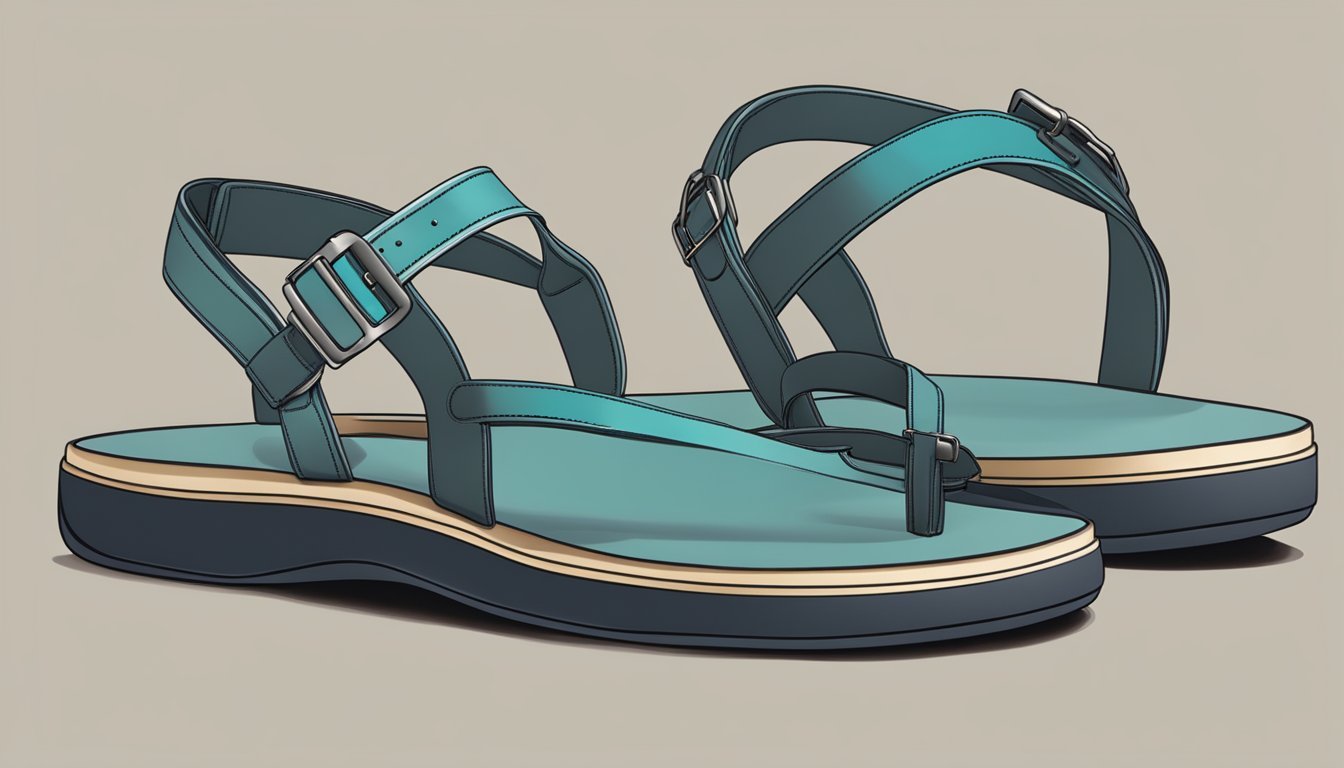How Should Sandals Fit: A Comprehensive Guide
Sandals are a popular choice of footwear for many people, especially during the summer months. However, finding the right fit can be a challenge, and it’s important to know how to properly evaluate and select the right pair of sandals to ensure comfort and support.

Understanding sandal fit is a crucial aspect of selecting the right pair. Unlike closed-toe shoes, sandals expose more of the foot and require a different approach to fitting. Factors such as the width, length, and arch support of the sandal should be considered to ensure a comfortable and secure fit. Additionally, evaluating different styles and features, such as the material and construction of the sandal, can also impact how they fit and feel on the foot.
Overall, selecting the right pair of sandals and ensuring they fit properly is essential for maintaining foot health and comfort. By understanding the key factors involved in sandal fit and taking the time to evaluate different styles and features, individuals can find the perfect pair of sandals for their needs and enjoy all the benefits they have to offer.
Key Takeaways
- Proper sandal fit is crucial for comfort and support.
- Evaluating different styles and features can impact how they fit and feel on the foot.
- Taking the time to find the right pair of sandals can help maintain foot health and comfort.
Understanding Sandal Fit
When it comes to sandals, getting the right fit is crucial for comfort and foot health. Ill-fitting sandals can cause blisters, calluses, and even foot pain. Therefore, it is essential to understand how sandals should fit and how to measure your foot size correctly.
Assessing Foot Shape
Before buying sandals, it’s important to assess your foot shape to find the right fit. Different foot shapes require different types of sandals. For example, if you have flat feet, you may need sandals with good arch support to prevent overpronation. On the other hand, if you have high arches, you may need sandals with extra cushioning to absorb shock.
Another factor to consider is the width of your foot. If you have wide feet, you may need to look for sandals with a wider footbed to prevent your foot from hanging over the edges. Conversely, if you have narrow feet, you may need to look for sandals with a narrower footbed to prevent your foot from sliding around.
Measuring Foot Size
To get the right fit, you need to measure your foot size accurately. The best way to do this is to trace your foot on a piece of paper and measure the length and width of the tracing. Then, compare your measurements to the sizing chart of the sandal you want to buy.
It’s important to note that sandal size may differ from your regular shoe size. Therefore, it’s crucial to measure your foot size every time you buy sandals, even if you think you know your sandal size. Additionally, it’s best to measure your foot size at the end of the day when your feet are at their largest.
In conclusion, understanding sandal fit is essential for comfort and foot health. By assessing your foot shape and measuring your foot size accurately, you can find the right fit and avoid foot problems.
Selecting the Right Size
When it comes to selecting the right size for sandals, there are a few factors to consider to ensure a comfortable fit. The following subsections cover some of the most important aspects of selecting the right size for your sandals.
Size Charts and Sizing Up or Down
One of the most important things to consider when selecting the right size for sandals is to consult the size chart provided by the manufacturer. Different brands may have different sizing standards, so it’s crucial to check the size chart before making a purchase. If you’re unsure about your size, it’s always a good idea to size up rather than down. Sandals that are too small can cause discomfort, blisters, and even long-term foot problems.
Width and Length Considerations
In addition to length, width is another critical factor to consider when selecting the right size for sandals. People with wide feet should look for sandals that come in “wide” sizes, while those with narrow feet should look for “narrow” sizes. It’s also important to ensure that the length of the sandal is appropriate for the foot. The toes should not be cramped, and the heel should not slip out of the back of the sandal.
Overall, selecting the right size for sandals is crucial for comfort and foot health. By consulting size charts and considering width and length, individuals can find sandals that fit well and provide the necessary support.
Evaluating Sandal Styles
When it comes to evaluating sandal styles, there are several factors to consider to ensure a comfortable and supportive fit. Here are some of the most important things to look for:
Strap Arrangements and Adjustability
One of the most important things to consider when evaluating sandal styles is the strap arrangement and adjustability. Straps should be adjustable to ensure a secure fit, but not too tight that they cause discomfort. Sandals with multiple straps can provide more support and stability, while strappy sandals can be more stylish and versatile.
Different Styles for Different Needs
Different styles of sandals are designed to meet different needs. Flip-flops are great for casual wear and beach trips, while wedge sandals can provide more support and comfort for all-day wear. Women’s sandals come in a wide variety of styles, from sporty to elegant, so it’s important to choose a style that meets your needs and matches your personal style.
When evaluating sandal styles, it’s important to consider factors such as strap arrangements, adjustability, and different styles for different needs. By taking these factors into account, you can ensure a comfortable and supportive fit that meets your needs and matches your personal style.
Comfort and Support Features
When it comes to sandals, comfort and support are the two most important factors to consider. A well-fitting sandal should have proper arch and heel support, as well as adequate cushioning and shock absorption.
Arch and Heel Support
Sandals with built-in arch support help to reduce foot fatigue and provide stability. The arch support should align well with the shape of the foot to distribute weight evenly and avoid undue strain on the feet. Some sandals, like wedges or high-heeled ones, have raised heels. When it comes to these, balance is key. The wearer should feel stable and confident while walking, not wobbly or uncertain. Ankle support is also important, especially for those with weak ankles or a history of ankle injuries.
Cushioning and Insoles
Cushioning and shock absorption are important features to look for in sandals. A good sandal should have a comfortable and supportive insole that provides cushioning and shock absorption. Insoles made of memory foam, cork, or gel are popular choices. The insole should also be removable and replaceable, so that the wearer can customize the fit and support of their sandals.
To summarize, a well-fitting sandal should have proper arch and heel support, adequate cushioning and shock absorption, and a comfortable and supportive insole. When trying on sandals, it’s important to walk around in them and make sure they feel comfortable and supportive. If the sandal doesn’t fit properly or doesn’t offer the necessary support, it can lead to foot pain and discomfort.
Material and Construction

When it comes to sandals, the materials used in their construction can make all the difference in how they fit and feel. Quality materials can provide both comfort and durability, ensuring that your sandals will last for many seasons to come.
Choosing Quality Materials
Leather sandals are a classic option that offer both style and durability. Leather is a breathable material that conforms to the shape of your foot over time, providing a custom fit. Look for sandals that use high-quality leather and have a soft lining to prevent rubbing and blisters.
For those who prefer more stretchy and elastic materials, there are many options available. Sandals with elastic straps can provide a snug fit that moves with your foot, while stretchy materials like neoprene can provide a comfortable, sock-like fit. However, it is important to ensure that the materials used in the construction of these sandals are of high quality to prevent stretching out or wearing down too quickly.
Importance of Flexibility and Stability
In addition to the materials used, it is important to consider the flexibility and stability of the sandals. A good pair of sandals should allow your foot to move naturally, without restricting your range of motion. Look for sandals with a flexible sole that can bend and move with your foot.
At the same time, it is important to ensure that the sandals provide enough stability to support your foot. Sandals with a contoured footbed or arch support can help distribute weight evenly and prevent strain on your feet. Additionally, sandals with a sturdy sole can help prevent slips and falls, providing added stability and support.
Overall, choosing sandals with quality materials and construction can make all the difference in how they fit and feel. By considering factors like flexibility, stability, and materials, you can find a pair of sandals that will provide both comfort and durability for all your warm-weather adventures.
Health and Foot Problems
When it comes to sandals, one of the most important things to consider is foot health. Ill-fitting sandals can lead to foot problems, such as plantar fasciitis, bunions, arch pain, calluses, corns, ingrown toenails, blisters, and discomfort. Therefore, it is important to choose sandals that fit well and provide adequate support.
Accommodating Foot Conditions
Individuals with foot conditions such as plantar fasciitis, bunions, or arch pain should look for sandals that provide proper support and cushioning. Sandals with a contoured footbed and arch support can help alleviate pain and reduce discomfort. Additionally, sandals with adjustable straps can accommodate foot swelling and provide a more customized fit.
Preventing Common Sandal Issues
To prevent common sandal issues such as blisters and discomfort, it is important to choose sandals that fit well and are made of high-quality materials. Sandals made of soft, flexible materials can reduce friction and prevent blisters. Additionally, sandals with a secure fit and proper support can reduce discomfort and prevent foot pain.
In summary, choosing the right sandals is crucial for foot health. Individuals should look for sandals that provide proper support, cushioning, and a customized fit. By doing so, they can prevent foot problems and enjoy comfortable, pain-free wear.
Fitting Techniques
When it comes to finding the perfect fit for sandals, there are a few techniques that can help ensure a comfortable and supportive fit. Here are some tips for finding the right fit:
Ensuring Proper Strap Fit
One of the most important aspects of sandal fit is the straps. Straps that are too tight can cause discomfort and even blisters, while straps that are too loose can make the sandals feel unstable and cause your foot to slide around. To ensure a proper fit, check that the straps are snug but not too tight. There should be enough room to wiggle your toes, but not so much that your foot is sliding around inside the sandal.
It’s also important to check for any overhang or spillage. If your foot is hanging over the edge of the footbed, the sandal is too small. On the other hand, if your foot is spilling out of the sides of the sandal, the sandal is too big.
Checking for Adequate Toe Room
Another important aspect of sandal fit is the toe box. The toe box should have enough room for your toes to move freely without feeling cramped or squished. There should be a little bit of wiggle room, but not so much that your foot is sliding forward in the sandal.
To check for adequate toe room, make sure that there is a little bit of space between your longest toe and the end of the sandal. You should be able to wiggle your toes freely without feeling like they are hitting the end of the sandal.
By following these fitting techniques, you can ensure that your sandals fit comfortably and provide the support you need for all your summer adventures.
Wear and Care Tips
Breaking in New Sandals
Breaking in new sandals is important to ensure that they are comfortable to wear. Wearing them for a few hours at a time for the first few days can help to prevent rubbing and swelling. It is also important to wear comfortable sandals that fit well to prevent pain and discomfort.
If new sandals are causing discomfort, try applying antiperspirant to the feet to reduce sweating and rubbing. Heel grips can also be added to the back of the sandals to prevent slipping and rubbing.
Maintenance for Longevity
Proper maintenance is important for the longevity of sandals. To prevent discoloration, avoid exposing them to direct sunlight for extended periods of time. Sandals should also be kept dry to prevent odor and bacteria growth.
To clean sandals, use a soft cloth or brush with mild soap and water. Avoid using harsh chemicals or abrasive materials that can damage the sandals.
By following these wear and care tips, users can ensure that their sandals remain comfortable and in good condition for longer periods of time.
Shopping for Sandals
When to Shop for the Best Fit
When shopping for sandals, it’s best to do so in the afternoon or evening. This is when the feet tend to be slightly larger due to daily activities and swelling, providing a more accurate fit. It’s also recommended to bring or wear the type of socks or insoles that will be worn with the sandals to ensure a proper fit.
Understanding Brand Sizing
Different brands may have variations in sizing, so it’s crucial to refer to the brand’s specific sizing chart before making a purchase. Additionally, understanding the specific heel height and the type of sandal, such as low heel or wedges, can help in selecting the most comfortable and appropriate fit.
Frequently Asked Questions
What is the ideal amount of space at the end of a sandal?
The ideal amount of space at the end of a sandal is about a half-inch. This space allows for your toes to move freely and helps prevent blisters and other foot injuries. However, the amount of space required may vary depending on the style of the sandal.
Should sandals be a size bigger or smaller for proper fit?
Sandals should fit snugly but not be too tight. You should not have to scrunch your toes to keep the sandal on, nor should your heel hang over the edge. It is recommended to try on sandals in your usual size and adjust accordingly based on the fit.
How can you determine if your sandals are too tight?
If your toes are cramped and your feet feel constricted, then your sandals are too tight. Additionally, if the straps leave marks on your skin or cause discomfort, then it’s a sign that the sandals are too tight.
What is the correct way to wear sandals?
The correct way to wear sandals is to slide your foot in and ensure that your toes and heel are positioned comfortably. The straps should fit snugly without being too tight or too loose.
How should the back strap of a sandal fit?
The back strap of a sandal should fit snugly around the heel to prevent slipping. However, it should not be so tight that it causes discomfort or irritation.
How do you ensure a sandal fits properly across the toes?
To ensure that a sandal fits properly across the toes, make sure that the straps do not dig into the skin or cause discomfort. The toes should be able to move freely without feeling cramped, and the straps should fit snugly without being too tight.









